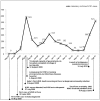Public Health Policy and Experience of the 2009 H1N1 Influenza Pandemic in Pune, India
- PMID: 29524939
- PMCID: PMC5819375
- DOI: 10.15171/ijhpm.2017.54
Public Health Policy and Experience of the 2009 H1N1 Influenza Pandemic in Pune, India
Abstract
Background: Prior experience and the persisting threat of influenza pandemic indicate the need for global and local preparedness and public health response capacity. The pandemic of 2009 highlighted the importance of such planning and the value of prior efforts at all levels. Our review of the public health response to this pandemic in Pune, India, considers the challenges of integrating global and national strategies in local programmes and lessons learned for influenza pandemic preparedness.
Methods: Global, national and local pandemic preparedness and response plans have been reviewed. In-depth interviews were undertaken with district health policy-makers and administrators who coordinated the pandemic response in Pune.
Results: In the absence of a comprehensive district-level pandemic preparedness plan, the response had to be improvised. Media reporting of the influenza pandemic and inaccurate information that was reported at times contributed to anxiety in the general public and to widespread fear and panic. Additional challenges included inadequate public health services and reluctance of private healthcare providers to treat people with flu-like symptoms. Policy-makers developed a response strategy that they referred to as the Pune plan, which relied on powers sanctioned by the Epidemic Act of 1897 and resources made available by the union health ministry, state health department and a government diagnostic laboratory in Pune.
Conclusion: The World Health Organization's (WHO's) global strategy for pandemic control focuses on national planning, but state-level and local experience in a large nation like India shows how national planning may be adapted and implemented. The priority of local experience and requirements does not negate the need for higher level planning. It does, however, indicate the importance of local adaptability as an essential feature of the planning process. Experience and the implicit Pune plan that emerged are relevant for pandemic preparedness and other public health emergencies.
Keywords: H1N1; India; Influenza; Local-Level Pandemic Response; Pandemic Preparedness Plans.
© 2018 The Author(s); Published by Kerman University of Medical Sciences. This is an open-access article distributed under the terms of the Creative Commons Attribution License (http://creativecommons.org/licenses/by/4.0), which permits unrestricted use, distribution, and reproduction in any medium, provided the original work is properly cited.
Similar articles
-
Pandemic planning and response in academic pediatric emergency departments during the 2009 H1N1 influenza pandemic.Acad Emerg Med. 2013 Jan;20(1):54-62. doi: 10.1111/acem.12061. Acad Emerg Med. 2013. PMID: 23570479
-
Assessing Argentina's response to H1N1 in austral winter 2009: from presidential lethargy to local ingenuity.Public Health Rep. 2011 Jan-Feb;126(1):9-12. doi: 10.1177/003335491112600104. Public Health Rep. 2011. PMID: 21337926 Free PMC article.
-
Pandemic influenza control in Europe and the constraints resulting from incoherent public health laws.BMC Public Health. 2010 Sep 3;10:532. doi: 10.1186/1471-2458-10-532. BMC Public Health. 2010. PMID: 20815888 Free PMC article.
-
The 2009 pandemic in Mexico: Experience and lessons regarding national preparedness policies for seasonal and epidemic influenza.Gac Med Mex. 2017 Jan-Feb;153(1):102-110. Gac Med Mex. 2017. PMID: 28128812 Review. English.
-
[A review on the preparedness plans on influenza pandemics, by WHO and China: the current status and development].Zhonghua Liu Xing Bing Xue Za Zhi. 2018 Aug 10;39(8):1032-1035. doi: 10.3760/cma.j.issn.0254-6450.2018.08.004. Zhonghua Liu Xing Bing Xue Za Zhi. 2018. PMID: 30180423 Review. Chinese.
Cited by
-
Source Code for Optimized Parallel Inception: A Fast COVID-19 Screening Software.Softw Impacts. 2022 Aug;13:100337. doi: 10.1016/j.simpa.2022.100337. Epub 2022 Jun 22. Softw Impacts. 2022. PMID: 35765602 Free PMC article.
-
The impact of lockdown policy on depressive symptoms among pregnant women in China: mediating effects of internet use and family support.Glob Health Res Policy. 2021 Mar 26;6(1):11. doi: 10.1186/s41256-021-00193-4. Glob Health Res Policy. 2021. PMID: 33771230 Free PMC article.
-
The psychological and clinical impact of the COVID-19 pandemic on orthopaedic patients: An Italian gender-specific analysis.Orthop Rev (Pavia). 2021 Mar 31;13(1):9005. doi: 10.4081/or.2021.9005. eCollection 2021 Mar 30. Orthop Rev (Pavia). 2021. PMID: 33953888 Free PMC article.
-
COVID-19 response in Nigeria: Health system preparedness and lessons for future epidemics in Africa.Ethics Med Public Health. 2020 Oct-Dec;15:100580. doi: 10.1016/j.jemep.2020.100580. Epub 2020 Aug 20. Ethics Med Public Health. 2020. PMID: 32844107 Free PMC article.
-
Adolescents' and parents' anxiety during COVID-19: is there a role of cyberchondriasis and emotion regulation through the internet?Curr Psychol. 2021;40(10):4750-4759. doi: 10.1007/s12144-020-01229-7. Epub 2021 Jan 3. Curr Psychol. 2021. PMID: 33424198 Free PMC article.
References
-
- Influenza (Seasonal). WHO website. http://www.who.int/mediacentre/factsheets/fs211/en/. Accessed February 7, 2016.
-
- Social and Economic Impact of Influenza - Article in Motion. http://www.rapidreferenceinfluenza.com/chapter/B978-0-7234-3433-7.50013-.... Accessed February 19, 2017.
Publication types
MeSH terms
LinkOut - more resources
Full Text Sources
Other Literature Sources
Medical


